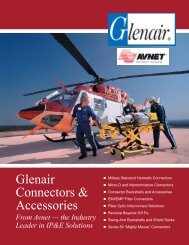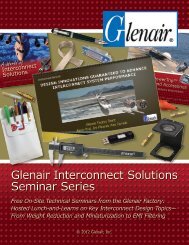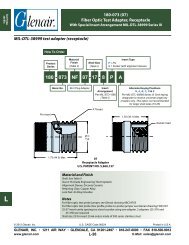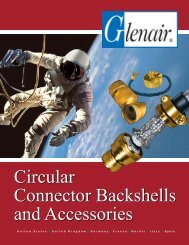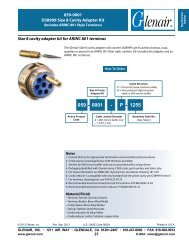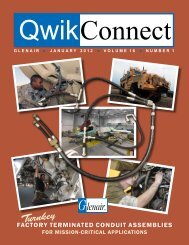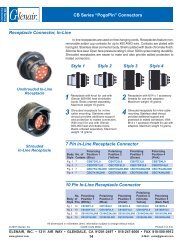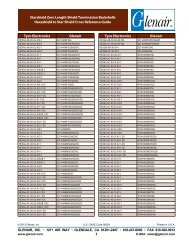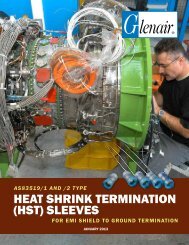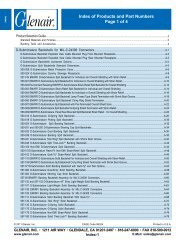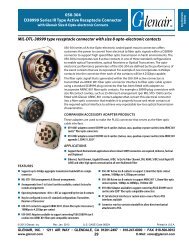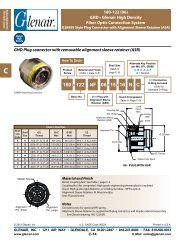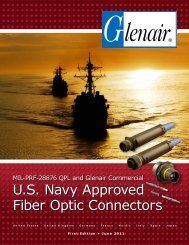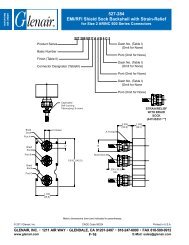October 2009 - Glenair, Inc.
October 2009 - Glenair, Inc.
October 2009 - Glenair, Inc.
You also want an ePaper? Increase the reach of your titles
YUMPU automatically turns print PDFs into web optimized ePapers that Google loves.
QwikConnect<br />
GLENAIR • O C T <strong>2009</strong> • V OLUME 13 • NUMBER 4<br />
MS<br />
Backshell<br />
Wall Chart<br />
Inside!<br />
Out of This World:<br />
Connector Accessory<br />
Lollapalooza!
QwikConnect<br />
<strong>Glenair</strong> Interconnect Solutions and...<br />
The Race for Space<br />
The Cold War between the Soviet Union and the<br />
Western powers led by the United States was<br />
in full vigor by the early 1950’s. The formation<br />
of military coalitions, a budding nuclear arms<br />
race, secret espionage programs and aggressive<br />
economic and technological competition were<br />
pronounced expressions of the conflict. While much<br />
of the Cold War was played out in secret or in proxy<br />
wars, one facet of the war was extremely public: The<br />
Space Race. The early days of the race for space<br />
focused on the development of rocket technologies,<br />
or launch vehicles, capable of delivering large<br />
payloads into space. Sergey Korolyov and Kerim<br />
Kerimov were the principal architects of the Soviet<br />
program, while Wernher von Braun directed the<br />
Wernher von Braun (1912 – 1977) a German American rocket<br />
physicist and astronautics engineer, universally recognized<br />
to be the preeminent rocket engineer of the 20th century.<br />
United States effort.<br />
When the Soviet-built Sputnik I became the<br />
first successful man-made satellite in space, and<br />
the Russian dog “Laika” became the first living<br />
creature to experience low-earth orbit, the battle<br />
for space dominance was truly on. As reports of an<br />
ever successful Soviet space program accumulated,<br />
pressure mounted in the United States to define<br />
space exploration as a national priority.<br />
The world’s first manned space flight was<br />
undertaken on April 12, 1961, when cosmonaut Yuri<br />
Gagarin made one orbit around the Earth aboard<br />
the Vostok 1 spacecraft. The United States became<br />
the second nation to achieve manned spaceflight,<br />
with the suborbital flight of astronaut Alan Shepard<br />
aboard Freedom 7, as part of Project Mercury.<br />
National pride was a significant motivator driving<br />
the pace of launch vehicle and payload technology<br />
development. For those who experienced the race for<br />
space “live,” the drama and excitement was palpable.<br />
And although <strong>Glenair</strong> never made the headlines, we<br />
were right there in the thick of the battle, producing<br />
an innovative range of interconnect products for the<br />
aircraft, missiles and the space industries.<br />
<strong>Glenair</strong> History Lesson:<br />
From Space-Grade Cables to the G1<br />
Connector Adapter and Clamp<br />
<strong>Glenair</strong> had its beginnings as a military-grade<br />
cable shop founded in Glendale, California in 1955.<br />
Pacific Automation Products, <strong>Inc</strong>. built complex,<br />
multi-conductor cables for ICBM missile and space<br />
launch vehicle applications. Located adjacent to a<br />
runway in Glendale’s Grand Central Air Terminal,<br />
“PAPI” developed innovative methods to build<br />
jacketed cable assemblies longer than the then<br />
existing maximum of 250 feet. PAPI workers would<br />
lay out the multi-conductor cables, sometimes up to<br />
1,000 feet in length, on the airport landing strip and<br />
Before LAX or Burbank’s Bob Hope International, the first and most important air travel center in the Los Angeles area was<br />
Grand Central Airport in Glendale. Grand Central offered the first paved runway west of the Rocky Mountains and served as<br />
the departure point for the nation’s first transcontinental airline service. Grand Central Airport appeared as a backdrop in many<br />
early films including Casablanca and was also the early home of Pacific Automation (PAPI) the antecedent of <strong>Glenair</strong>. <strong>Inc</strong>.<br />
carefully blow on neoprene jacketing—struggling to<br />
keep the material from popping due to the tarmac’s<br />
heat and the air pressure used for inflation. By the<br />
way, this jacketing technique, eventually perfected, is<br />
still in use today in <strong>Glenair</strong>’s cabling operation.<br />
Interestingly, even though these connectorized<br />
cables were destined for use in extremely high-tech<br />
space systems, their design was relatively simple<br />
by today’s standards. At the time, electromagnetic<br />
interference (EMI) was still not much of a concern,<br />
due to the limited number of electronic devices used<br />
in aerospace applications. In fact, most interconnect<br />
cables were equipped with simple strain-relief clamps<br />
and little else to protect the connector and cable from<br />
damage. But the rapid expansion of radio and other<br />
wave spectrum devices in aircraft and space systems<br />
heightened the number and severity of EMI and RFI<br />
problems. Pacific Automation was an early leader<br />
in the design and development of metal-wire braid<br />
shielding innovations to prevent EMI from grounding<br />
to cable conductors. The new braided material<br />
effectively shielded sensitive electronic equipment<br />
from EMI noise sources such as engine magnetos.<br />
Most mil/aero connector companies in the<br />
50’s shipped their connectors with a simple cable<br />
clamp for strain-relief. But there was no connector<br />
rear-end standardization across the industry and<br />
every connector company basically followed their<br />
own design for the number and size of threads and<br />
interlocking teeth they would incorporate onto the<br />
back-end of the connector. The increased use of<br />
braided shielding added additional complexity, as<br />
the need for shield termination backshells was fast<br />
becoming a universal requirement. But again, each<br />
connector company took a unique approach to<br />
solving the problem and controlling mil-specs were<br />
only just being formulated and enforced.<br />
So, the clever folks at Pacific Automation<br />
Products decided to help their cable customers—<br />
stymied by the proliferation of non-standard<br />
thread geometries and the new shield termination<br />
technologies—by launching a line of connector<br />
adapters that could be used across the broad range<br />
of mil/aero connectors. And since PAPI wanted to sell<br />
the new backshell products to all the other cable shops<br />
producing military-grade cable assemblies, they set-up<br />
QwikConnect • <strong>October</strong> <strong>2009</strong> QwikConnect • <strong>October</strong> <strong>2009</strong><br />
2 3
QwikConnect<br />
their new backshell enterprise as a separate entity to<br />
avoid potential conflicts with their erstwhile competitors.<br />
And so <strong>Glenair</strong> was born.<br />
Located directly across the street from PAPI,<br />
<strong>Glenair</strong> took its name from the city of Glendale and the<br />
company’s street address on Air Way. <strong>Glenair</strong>’s first<br />
product, the G1 connector adapter and cable clamp,<br />
covered all the high reliability mil/aero connectors then<br />
in existence. And in case you are wondering, yes, we<br />
still produce and stock the G1 part. The rapid growth<br />
of the aerospace industry in Southern California meant<br />
<strong>Glenair</strong>’s growing line of connector accessories was<br />
in high demand. And soon the success of the startup<br />
backshell business had far outstripped that of the<br />
original enterprise PAPI. And so, following a series<br />
of organizational changes, the parent company PAPI<br />
reversed roles to become the cable division of the now<br />
prospering start-up. 53 years later,<br />
<strong>Glenair</strong> is still in operation at 1211 Air<br />
Way in Glendale, California and we<br />
are still making cables, backshells—<br />
and a whole lot more—adjacent to the<br />
former runways of Grand Central.<br />
Throughout the ensuing years,<br />
<strong>Glenair</strong> has continued its tradition of<br />
innovation with new wire protection,<br />
shield termination and other connector<br />
accessory solutions. We started<br />
with the simple idea that the industry<br />
needed standardized connector<br />
accessories to accommodate cable clamps, backshells<br />
and other hardware to fit the many specialized circular<br />
and rectangular connectors in use in high-reliability<br />
interconnect systems. This issue of QwikConnect is<br />
designed to give you a complete overview of these<br />
essential connector accessory products.<br />
At Disney they say “it all started with a mouse.”<br />
At <strong>Glenair</strong> it was an industry-standard cable clamp,<br />
the G1. From this humble beginning <strong>Glenair</strong> has<br />
evolved into one of the world’s premier interconnection<br />
manufacturers with a dozen full-spectrum product lines<br />
designed to meet every high-reliability interconnect<br />
requirement. In the pages that follow we present a<br />
virtual cornucopia of useful information for the buyer<br />
and user of <strong>Glenair</strong>’s “Out of This World” line of<br />
connector accessory products. For a free sample of any<br />
of our connector accessory products, please call the<br />
factory or contact your local <strong>Glenair</strong> Sales Group.<br />
Engineering:<br />
A Matter of Facts<br />
Greg Brown, Vice President, Engineering<br />
<strong>Glenair</strong> is a component manufacturer and,<br />
as such, is rarely in complete control of the<br />
larger systems to which our parts contribute.<br />
Nonetheless, we know that small problems<br />
at the component level can have significant<br />
impact on system performance.<br />
Whether from a mil-spec or a customer,<br />
specifications can sometimes be ambiguous<br />
or inadequate. That’s why we’ve found<br />
it’s never enough to just say that a design<br />
“meets the spec.” Our consistent goal is that<br />
the component truly solves the customer’s<br />
problem. By our reckoning, rigidly designing<br />
to spec is the surest pathway to unforeseen<br />
engineering failures.<br />
Circular<br />
Connector Backshells<br />
and Accessories<br />
U n i t e d S t a t e s U n i t e d K i n g d o m G e r m a n y F r a n c e N o r d i c I t a l y S p a i n<br />
Rectangular<br />
Connector<br />
Backshells<br />
U n i t e d S t a t e s • U n i t e d K i n g d o m • G e r m a n y • F r a n c e • N o r d i c • Italy • Spain<br />
The <strong>Glenair</strong> Suite of Connector Accessory Documentation:<br />
Circular, Rectangular, Composite and Mil-Spec<br />
We have a great team of engineers and<br />
application specialists at <strong>Glenair</strong>—in fact we<br />
believe it to be the largest and most experienced<br />
in the industry. And everyone on the team is<br />
dedicated to our philosophy of “solving the<br />
problem” versus simply “following the spec.”<br />
Sales and marketing drawings are one of<br />
the principal engineering outputs that help<br />
customers choose the right product for each<br />
application out of the thousands of available<br />
options. Our engineering group also completes<br />
in-house as well as qualification-related testing<br />
to ensure customers may be thoroughly briefed<br />
on the performance attributes of our products.<br />
In both instances, we are committed to<br />
making decisions based on objective facts and<br />
direct observations. It’s our sense that basing<br />
important decisions on guesses, assumptions<br />
or wishful thinking can only lead to failure. As<br />
we like to say: “we manage by fact because the<br />
alternative is so ugly.”<br />
Composite Thermoplastic<br />
Connectors and Accessories<br />
Plus Composite Enclosures, Conduit Systems,<br />
Braided Shielding, Assembly Tools and More!<br />
U n i t e d S t a t e s • U n i t e d K i n g d o m • G e r m a n y • F r a n c e • N o r d i c • I t a l y • S p a i n • J a p a n<br />
Four Reasons to Choose<br />
Composites for Your<br />
Next Interconnect Application<br />
<strong>Glenair</strong>'s composite interconnect components are manufactured from<br />
high-grade engineering thermoplastics for the toughest application<br />
environments. Specifically geared for high-performance air, sea, land and<br />
space applications, <strong>Glenair</strong>'s line of composite connectors and backshells<br />
are ideally suited for systems which require electromagnetic compatibility,<br />
reliable environmental protection and long-term durability. Here's why:<br />
Corrosion Resistance: One of the<br />
most appealing attributes of composites<br />
is their unlimited corrosion resistance as<br />
compared to conventional metal materials.<br />
Aluminum interconnect components, for<br />
example, are subject to galvanic coupling<br />
which causes the material to be “sacrificed”<br />
to its cadmium/nickel plating. Since hightemperature<br />
composite plastic is not<br />
sacrificial to plating, finished products last<br />
longer, require less maintenance and so<br />
directly reduce the overa l cost of ownership<br />
of the interconnect system.<br />
The World's Most Complete Selection<br />
Vibration Dampening: Unlike metals,<br />
polymer plastics are less subject to harmonic<br />
resonance due to their lighter weight and<br />
inherent attenuating properties. Which<br />
means threaded components made from<br />
these materials are far less likely to vibrate<br />
loose when subjected to prolonged periods<br />
of vibration and shock. Again, reduced<br />
maintenance and reduced cost of ownership<br />
are the major benefits realized by systems<br />
built from vibration dampening composite<br />
thermoplastics.<br />
Weight Reduction: Composites offer<br />
increased strength at lighter weights . Weight<br />
savings for composites over aluminum<br />
are approximately 40% (depending on<br />
component design). Savings versus other<br />
materials are even more pronounced:<br />
up to 80% for stainless steel and brass.<br />
Composite materials directly reduce aircraft<br />
empty weights and increase fuel fractions—<br />
resulting in sma ler, lower-cost aircraft that<br />
use less fuel to perform a given mission.<br />
Durability: <strong>Glenair</strong>'s line of composite<br />
thermoplastic interconnect components<br />
are cleverly designed to avoid many of<br />
the durability problems associated with<br />
conductive plated parts. Through the use<br />
of selective plating—which limits easy-toscratch<br />
plated surfaces to the protected<br />
portions of the part—<strong>Glenair</strong> has effectively<br />
eliminated superficial damage to coupling<br />
nuts, saddle bars and box exteriors. The<br />
parts are free from visible wear-and-tear<br />
problems that forces premature replacement<br />
of backshe ls, connectors, box assemblies<br />
and other EMC interconnect components.<br />
Mil-Spec Backshells and<br />
Connector Accessories<br />
3rd Edition • <strong>October</strong> <strong>2009</strong><br />
U n i t e d S t a t e s • U n i t e d K i n g d o m • G e r m a n y • F r a n c e • N o r d i c • I t a l y • S p a i n • J a p a n<br />
In this same vein, <strong>Glenair</strong> engineers<br />
understand that their profession is<br />
governed by a code of ethics published<br />
by the National Society of Professional<br />
Engineers. The key points of the code are:<br />
• Keeping the need for public safety<br />
highest in mind<br />
• Staying within ones area of<br />
competence<br />
• Being truthful when speaking as a<br />
professional<br />
• Being faithful to the client<br />
• Practicing honorable conduct at all<br />
times.<br />
We don’t claim that we never make<br />
mistakes. But we are sincere when we tell<br />
our customers that they will always get our<br />
honest best, and the straight facts, when it<br />
comes to <strong>Glenair</strong> engineered products.<br />
QwikConnect • <strong>October</strong> <strong>2009</strong> QwikConnect • <strong>October</strong> <strong>2009</strong><br />
4 5
Backshells at Work<br />
The broad range of backshell types available<br />
today make it critical for interconnect engineers,<br />
and others tasked with the responsibility of<br />
specifying connector accessories to become adept<br />
at building backshell part numbers. For the most<br />
part, the process entails selecting options from the<br />
part number development trees.<br />
But experience shows it is equally important<br />
to consider the working environment of the target<br />
application before completing the backshell<br />
selection process. There are many electrical,<br />
mechanical and environmental considerations<br />
which, when properly addressed, will ensure a long<br />
functional life for the interconnect system.<br />
The Backshell Selection Guide on the<br />
following pages presents a step-by-step explanation<br />
of this process. But before we delve into the exciting<br />
details of backshell part number development it is<br />
worthwhile to digress for a moment and talk about<br />
cables and conduit.<br />
Cable and Conduit Make-up<br />
Some very basic questions in the backshell<br />
selection process cannot be answered without an<br />
understanding of the overall make-up of the wire<br />
and cable used in the assembly. Basic dimensional<br />
decisions on cable entry size (see Table I on the<br />
opposite page) cannot be specified without accurate<br />
descriptions and measurements of the cable or wire<br />
bundle. A basic analysis of the cable should include:<br />
• Wire Numbers and Types: twisted shielded<br />
pairs, coaxial power, signal, fiber optic, etc.<br />
• Shield Material Gauge, Number and Type:<br />
tin, nickel, silver plated copper wire, and so on.<br />
• Jacket material properties.<br />
In addition to standard cables, many customers<br />
prefer to use circuit protection products such as<br />
convoluted tubing and/or metal-core conduit. These<br />
products also employ backshell-like devices to assist<br />
in the routing of wires or connection to feed-through<br />
fittings and connectors. Conduit systems are intended<br />
for use in airframe applications, military vehicles, rail,<br />
shipboard and transportation systems that require<br />
performance attributes not supplied by cable.<br />
QwikConnect<br />
The wire harnesses under the hood of your<br />
automobile, for example, are rarely enclosed in<br />
cable jacketing as the complexity of the routing<br />
and the sheer number of interconnected devices<br />
makes this an impractical choice. There are<br />
obviously many ways to protect wiring, and the<br />
choice of which product to use depends on the<br />
nature of the potential electromagnetic interference,<br />
environmental damage and physical abuse<br />
experienced by the assembly. Other factors, such<br />
as the ability to readily open the system for repair,<br />
add or subtract individual wires from the assembly,<br />
or reduce weight also come into play. While the<br />
following selection guide is clearly geared to cabled<br />
systems, <strong>Glenair</strong> also supplies an equally broad<br />
range of choices for conduit. See www.glenair.com<br />
for additional information.<br />
The heart of every interconnect cable assembly is the multiconductor<br />
cable. As early in the application development<br />
process as possible it is critical to document the wire gauges,<br />
core type, insulation/dielectric materials, media types (copper,<br />
aluminum or optical), shielding (individual conductor and<br />
overall), jacketing, and all other elements that contribute<br />
to the mechanical and dimensional properties of the cable.<br />
By the way, <strong>Glenair</strong>’s cable shop can supply the cable,<br />
particularly for unusual or short run applications.<br />
Calculating Wire Bundle Diameter<br />
A backshell's rear cable entry can accommodate only a narrow range of cable diameters. When selecting the backshell cable<br />
entry size from the provided tables, it is a good idea to err on the side of too large, as an undersized cable can always be enlarged<br />
with tape or a grommet to fit the cable clamp. When calculating wire bundle diameters, note that the gauge of the wire<br />
describes only the diameter of the metal conductor, and not the overall diameter including insulation and/or braids. Refer to the<br />
appropriate wire specification for the actual diameter of the wire for use in the following calculations.<br />
Steps<br />
(1a) Determine average wire diameter when<br />
all wires are the same diameter; or<br />
(1b) Determine average wire diameter when<br />
wires are different diameters.<br />
(2) Multiply average wire diameter by factor<br />
from Table I below<br />
(3) Add thickness of any shielding or jacketing<br />
to core wire bundle diameter (for example,<br />
add .025 for braided sleeving)<br />
BORN IN THE<br />
TABLE TABLE I I<br />
Calculations<br />
Given 30 Wires @ .045 DIA<br />
Avg. Wire DIA = .045<br />
Given 15 Wires @ .045 and 15 Wires @ .135<br />
15 x .045 = .68<br />
15 x .135 = 2.03 + 2.71 = .090 Avg. Wire DIA<br />
= 2.71 30<br />
(1a) .045 x 6.7 = .3015 Core Wire Bundle DIA<br />
(1b) .090 x 6.7 = .603 Core Wire Bundle DIA<br />
(1a) .3015 + .025 = .3265 Wire Bundle Outside DIA<br />
(1b) .603 + .025 = .628 Wire Bundle Outside DIA<br />
No. of Wires 1 2 3 4 5 6 7 8 9 10 12 14 16 18 20 24 28 32<br />
Factor 1.0 2.0 2.2 2.4 2.7 2.9 3.0 3.3 3.8 4.0 4.3 4.6 5.0 5.3 5.6 6.0 6.5 6.9<br />
No. of Wires 36 40 45 50 55 60 65 70 75 80 90 100 125 150 175 200 250 300<br />
Factor 7.4 7.7 8.1 8.5 8.9 9.3 9.7 10.1 10.5 10.9 11.6 12.2 13.7 15.0 16.1 17.2 19.3 21.0<br />
Domestic Materials<br />
Domestic Labor<br />
<strong>Glenair</strong> backshells are manufactured<br />
at our 1211 Air Way factory (some 450,000<br />
square feet) in Glendale, California. Vertically<br />
integrated, <strong>Glenair</strong> directly manages all aspects<br />
of fabrication including die-casting, precision<br />
machining, plating, and assembly. While we<br />
would be the first to agree that quality products<br />
are made all over the world, we are nevertheless<br />
proud to earn and keep our customers’ trust<br />
and loyalty with products made right here in<br />
Southern California.<br />
QwikConnect • <strong>October</strong> <strong>2009</strong> QwikConnect • <strong>October</strong> <strong>2009</strong><br />
6 7
QwikConnect<br />
Backshell and Connector Accessory Glossary<br />
of Essential Terms<br />
Adapter: Generic term for a threaded shell that<br />
facilitates the attachment of cable-clamps and<br />
other accessories to the back end of a cylindrical<br />
connector.<br />
Angle/Profile: The straight, 45° or 90°<br />
configuration of a connector backshell. Allows system<br />
designers to specify the exact route a cable will take<br />
as it enters/exits the back end of the connector.<br />
Backshell: Any one of thousands of end-bell<br />
shaped connector accessories that provide EMI<br />
shield termination, environmental sealing or other<br />
functions when attached to the back end of a<br />
connector.<br />
Band Porch: The area on an EMI shield<br />
termination backshell where braided cable or wire<br />
shielding is terminated (attached) by means of a<br />
banding strip, crimp ring or other device.<br />
Bent Tube: Manufacturing process used to<br />
fabricate angled parts. The smooth, full-radius bend<br />
is often specified for fiber optic media or other wire<br />
types with bend radius restrictions.<br />
Connector Accessory: Generic term for<br />
the broad family of parts designed to improve the<br />
performance of connectors by providing cable strainrelief,<br />
environmental sealing, EMI shield termination<br />
and so on.<br />
Coupling Nut: Threaded portion of the backshell<br />
that enables reliable attachment of the connector<br />
accessory to the back end of the connector. Various<br />
styles such as free-spinning and self-locking are<br />
specified depending on application requirements.<br />
Cable Entry/Exit: In a correctly sized backshell,<br />
the OD of the cable will fit easily into the rear-end<br />
of the backshell but not be too loose as to limit<br />
the effectiveness of the cable clamp. In backshell<br />
part number development the cable entry/exit is<br />
generically referred to at the “dash number” and is<br />
selected from a table according to the diameter of the<br />
cable.<br />
Crimp Ring: Malleable aluminum band, typically<br />
factory installed, used to terminate (attach) braided<br />
cable shielding to a backshell.<br />
Cable Clamp: Simple strain-relief device,<br />
typically made up of saddle-bars and fasteners, used<br />
to prevent wires and cables from being pulled from<br />
the backend of a connector.<br />
Connector<br />
Interlocking<br />
Teeth<br />
Coupling Nut<br />
Backshell<br />
Cut and Welded: manufacturing process used<br />
to fabricate angled backshells, when a tooled<br />
(die-cast) equivalent does not exist.<br />
Commercial: Term used to refer to connector<br />
accessories (or other interconnect components) that<br />
are built to non-mil-spec specifications. Typically<br />
commercial backshells are preferred when a<br />
particular feature is not available in the applicable<br />
mil-spec.<br />
Ground<br />
Ring<br />
Connector Designator: Alphabetic code used<br />
in connector accessory part number development<br />
used to indicate the series of connector the part is<br />
designed to fit.<br />
Dash Number: Numeric code used in backshell<br />
part number development used to indicate the inside<br />
diameter of the rear opening of a part.<br />
Die Cast: Metal part fabrication process in which<br />
molten aluminum is shot into a die (a type of mold)<br />
under high pressure. Die cast parts require expensive<br />
tooling on the front end but are considered less costly<br />
to produce over time.<br />
Extender: Backshell component part used to<br />
lengthen the enclosed and protected area behind the<br />
connector. Typically used to house wire service loops<br />
or simply to provide extra working room for contact<br />
termination.<br />
Ground<br />
EMI Ring<br />
Shielding<br />
Compression<br />
Nut<br />
Saddle Bars<br />
Environmental: A class of connector accessory<br />
that uses various sealing technologies such as<br />
o-rings and grommets to prevent contamination of<br />
the wire-to-connector contact area.<br />
Finish/Plating: The application of conductive<br />
and non-conductive materials to the surface<br />
of the connector or backshell, typically via an<br />
electrochemical process. Surface plating provides<br />
corrosion protection and a ground path for EMI.<br />
Mil-Spec: Controlling specifications, originally<br />
authored and maintained by various branches of<br />
the military governing the form, fit and function of<br />
connector accessories and other products used in<br />
military equipment. Many mil-specs, such as the<br />
AS85049 backshell specification, are now maintained<br />
by third-party commercial organizations<br />
such as the SAE.<br />
Nut-Ring: Connector accessory used<br />
as an aid in attaching receptacle connectors<br />
to bulkheads and boxes.<br />
Protective Cover: Also called a dust cap, the<br />
protective cover prevents damage to the front-end of<br />
a connector when the interconnect is unmated.<br />
Stowage Receptacle: Accessory device used<br />
as an attachment point on a box or wall for cable<br />
plugs or dust caps when in the unmated condition.<br />
Style II: Term used to refer to a backshell<br />
with a stepped design that accommodates<br />
a large cable entry on the back end of a<br />
backshell and a small coupling<br />
nut on the front.<br />
Shield Termination: EMI/RFI backshells<br />
are specified when individual wires or<br />
overall cables are equipped with braided EMI/RFI<br />
shielding. The shielding is terminated (attached)<br />
to the backshell using various means in order to<br />
create a ground path for any EMI that has<br />
bonded to the cable shield.<br />
Strain-Relief: Connector accessory, typically a<br />
cable clamp, used to prevent wire conductors from<br />
being pulled out of the connector during use.<br />
Shell Size: Numeric code used in<br />
backshell part number development used to<br />
indicate both the size of the backshell and<br />
the size of the connector it attaches to.<br />
Careful attention is required as the number size<br />
of the backshell and the connector are not always<br />
the same (for example in the case of D38999<br />
connectors that use alphabetic shell sizes).<br />
Shrink Boot Adapter: A type of rear-end<br />
connector accessory used for the attachment of<br />
shrink boots for strain-relief and environmental<br />
sealing.<br />
Tag-Ring: Type of EMI/RFI backshell particularly<br />
well suited for the termination of individual wire<br />
shields.<br />
8<br />
QwikConnect • <strong>October</strong> <strong>2009</strong> QwikConnect • <strong>October</strong> <strong>2009</strong> 9
QwikConnect<br />
Backshell-to-Connector<br />
Coupling<br />
<strong>Glenair</strong> offers four different coupling styles to<br />
meet every application requirement:<br />
Direct Coupling<br />
Direct couplers thread directly onto the connector<br />
by rotating the entire part. A separate toothed follower<br />
provides backshell-to-connector grounding.<br />
Rotatable Coupling<br />
Rotatable designs utilize a free-spinning, toothed<br />
coupling nut for easier installation.<br />
Self-Locking, Rotatable Coupling<br />
Rotatable Self-Lockers add a ratcheted detent "clicker"<br />
to prevent de-coupling due to extreme vibration and<br />
shock.<br />
Positive-Lock, Non-Detent Coupling<br />
<strong>Glenair</strong> Mod Code -445 ("NESTOR") coupling<br />
mechanism corresponds to AS85049 style "N" non-detent,<br />
rotatable coupling with spring-loaded interface.<br />
Backshell Selection Guide<br />
The design and development of today’s broad<br />
range of connector accessories took over 50<br />
years to complete, and the number of types<br />
and styles is truly extraordinary. <strong>Glenair</strong>’s Circular<br />
Connector Accessories catalog, for example,<br />
presents 24 different categories of backshells and<br />
other accessories. The D-Subminiature portion of<br />
our new Rectangular Accessories catalog features<br />
over 30 different styles of backshells for use with<br />
popular rack and panel connectors. <strong>Glenair</strong> also<br />
produces dozens of different composite and fiberoptic<br />
backshell designs, not to mention thousands<br />
of Mil-Spec configurations. Perhaps the most<br />
revealing figure is the 70,000 part numbers—<br />
mostly connector accessories—now available in<br />
our Same-Day Inventory. The staggering number<br />
of backshell types available today makes it all the<br />
more important for interconnect engineers, and<br />
others tasked with the responsibility of specifying<br />
connector accessories, to become expert at the art<br />
of backshell selection. Here are the basics:<br />
Step One: Determine Accessory<br />
Functionality and Performance<br />
Requirements<br />
The first step in successful backshell selection<br />
is proper product application: In other words, what<br />
exactly is the accessory supposed to do, and what<br />
are the conditions in which it must accomplish its<br />
job? It’s not enough, for example, to know that the<br />
accessory must provide strain-relief. It’s critical<br />
to also understand the working environment—the<br />
high heat of an engine compartment, for example<br />
—before moving forward in the selection process.<br />
And the more complex the application, the more<br />
detailed the questions need to become, lest some<br />
important functionality or performance requirement<br />
be forgotten.<br />
The following questions will reveal the most<br />
critical functional and performance requirements for<br />
the accessory, and help a knowledgeable engineer<br />
make the best design, material and plating selections:<br />
(1) What is the intended working environment of the<br />
interconnect system—shipboard, space, airframe,<br />
ground support and so on?<br />
(2) What level of environmental protection is required<br />
—full water immersion, moisture resistance, chemical/<br />
caustic fluid resistance, extreme corrosion resistance,<br />
mud?<br />
(3) What level of electromagnetic shielding is<br />
required—overall cable shielding, individual<br />
conductor or both? Is any particular style of shield<br />
termination required in the target assembly?<br />
(4) What level or amount of strain-relief, from light<br />
duty to gorilla proof, is required to protect shield and<br />
conductor terminations from damage?<br />
(5) What is the temperature range of the application<br />
environment? Is it so hot that stainless steel is<br />
called for, or is it so cold that a special elastomeric<br />
seal should be specified?<br />
(6) Is repairability a design requirement? Some split<br />
shell designs make field repair a snap, while some<br />
solid shell models make repair and maintenance<br />
extremely difficult.<br />
(7) Are there size or shape constraints which need<br />
to be considered? Is working room so important, for<br />
example, that a long extender should be designed<br />
in? Or is available space so tight that a low profile<br />
design is called for? Does cable routing dictate 45°,<br />
90° or straight cable entries?<br />
(8) Is a metal shell required or is composite<br />
thermoplastic an option? Is saving weight so critical,<br />
in other words, that only composite backshells need<br />
apply? Or is metal preferred due to cost, strength or<br />
design approvals?<br />
(9) And speaking of approvals, does the application<br />
require performance per AS85049 or another<br />
commercial, military or industrial performance<br />
specification?<br />
Step Two: Determine Connector Part<br />
Number and Interface Designator<br />
By 1970, Mil-Spec connector documentation<br />
controlled the interface mateability of plug to<br />
receptacle for all the major circular connector<br />
families —MIL-DTL-5015, MIL-DTL-28840, MIL-DTL-<br />
38999 and so on. Which meant that no matter who<br />
manufactured the connectors they would, at least in<br />
theory, intermate with the same family of parts from<br />
any other manufacturer.<br />
Shortly thereafter, rear connector-to-accessory<br />
Cable Sealing Backshells<br />
Submersible Backshells<br />
This Cable Sealing Backshell offers immersion<br />
protection to 6 ft. when used with impervious jacketed<br />
cables. A resilient grommet which fits into a counterbore<br />
in the backshell compresses and seals against the cable<br />
jacket when the threaded strain relief is tightened.<br />
Water-Tight Backshells<br />
This Cable Sealing Backshell provides a resilient<br />
grommet, that prevents water incursion up to 3 ft., as an<br />
integral part of the cable strain relief.<br />
Splash-Proof Backshells<br />
For moisture resistance and sealing against dust only,<br />
<strong>Glenair</strong> offers Environmental Resisting Backshells. An<br />
effective sealing barrier is created by a resilient grommet<br />
at the backshell cable entry.<br />
Environmental Shrink-Boots<br />
For use with series 311, 319 and 440 type backshells,<br />
<strong>Glenair</strong> “Full Nelson” Shrink Boots provide dependable<br />
sealing of cable assemblies.<br />
10 QwikConnect • <strong>October</strong> <strong>2009</strong><br />
QwikConnect • <strong>October</strong> <strong>2009</strong> 11
QwikConnect<br />
Strain-Reliefs<br />
Typical Mil/Aero cable assemblies often have<br />
over a hundred wires terminated to a single<br />
connector. Preventing the wires from pulling<br />
on the contacts and damaging the termination<br />
is critical, and is usually accomplished with a<br />
strain-relief clamp or shrink-boot that isolates<br />
the pulling strain applied to the cable. Strain relief<br />
on electrical connectors can be accomplished<br />
in other ways, such as with a wire service<br />
loop that allows the wire to move between the<br />
clamping device and the contact without overstressing<br />
the termination. But the basic method<br />
of clamping the wire bundle or cable jacket with<br />
saddle bars is the most common method of<br />
protecting contact terminations.<br />
• Straight and<br />
Angled Strain<br />
Reliefs<br />
• Qwik-Ty®<br />
• Series 77<br />
“Full Nelson”<br />
Shrink-Boots<br />
• Light, Medium and<br />
Heavy-Duty<br />
Saddle Bars<br />
• QwikClamp ®<br />
interface geometries were also standardized and<br />
came under the control of a number of military<br />
specifications, principally MIL-C-85049. This meant<br />
it was no longer necessary for accessory makers<br />
to consider both the connector type, shell size as<br />
well as manufacturer in order to correctly mate their<br />
accessories to a given family of connectors.<br />
Today, interconnect system designers simply<br />
need to identify the correct part number for the<br />
chosen connector and match it to an alphabetic<br />
interface designator to select accessories which<br />
correctly fit the part. Tables listing all the major<br />
connector-to-accessory interface designators used<br />
by <strong>Glenair</strong> can be found in the Backshell Interface<br />
Standards table in the general information section of<br />
the Circular Connector Accessories catalog.<br />
While the interface designators take much of the<br />
guess work out of the process, it is still important to<br />
evaluate the chosen connector in terms of application<br />
performance requirements. And if necessary, to work<br />
with <strong>Glenair</strong> engineering to suggest an alternative<br />
connector for the application.<br />
Step Three: Determine Cable Make-up<br />
Several key questions in backshell selection<br />
cannot be answered without a solid understanding<br />
of the overall make-up of the cable and harness on<br />
which the accessory will be used. Basic dimensional<br />
elements, for example the diameter of the backshell<br />
cable entry, cannot be specified without accurate<br />
OD measurements of the cable or wire bundle in<br />
hand.<br />
As mentioned, the make-up of the cable and the<br />
selection of strain-relief, environmental protection<br />
or shield termination technologies go hand-in-hand.<br />
At the risk of waxing pedantic, it has been our<br />
experience that significant problems, such as an<br />
unanticipated susceptibility to EMI in the electronic<br />
equipment serviced by the cable, are much less<br />
costly to resolve when tackled at this stage of<br />
the design process. Imagine the difficulty of reengineering<br />
a printed circuit board or a re-building<br />
a complex interconnect cable because you failed to<br />
optimize cable shielding and grounding back when it<br />
was easier to accomplish.<br />
Many EMI filter connector customers, for<br />
example, find themselves in this situation after<br />
finished systems fail to pass required EMC testing.<br />
Making sure the cable fits through the backshell is<br />
a basic but important task. Making sure the right<br />
EMI shield termination and grounding technologies<br />
get designed into the system is perhaps even more<br />
important, but it is all too often an overlooked step in<br />
the process.<br />
Product<br />
Series<br />
320 - F S 001 M 16 - 3<br />
Connector<br />
Designator<br />
Angular<br />
Function<br />
A = 90°<br />
B = 45°<br />
C = Straight<br />
Basic<br />
Part No.<br />
Finish<br />
(Table I)<br />
Step Four: Develop Accessory<br />
Part Number<br />
Shell<br />
Size<br />
(Table II)<br />
Length<br />
1/2 inch increments,<br />
e.g. 3 = 1.5 inches.<br />
Minimum order length<br />
1.0 inch.<br />
<strong>Glenair</strong> follows a standardized format for<br />
the development of accessory part numbers, so<br />
mastering the process once will enable you to build<br />
valid part numbers from any accessory product<br />
family—circular, rectangular, composite, shipboard,<br />
fiber optic, and so on. Some differences are of<br />
course to be found from one product series to the<br />
next because of the range of available options. But<br />
the following steps should serve as general enough<br />
guide to the process for most accessories:<br />
(1) Select the Product Series: do you want a dust<br />
cap, a banding adapter, an environmental backshell<br />
or a Qwik-Ty? Use the product selection guide in<br />
each catalog to find the right numbered product<br />
series. Mil-Spec connector accessories use slashsheet<br />
nomenclature, but are cross-referenced in<br />
every catalog to the <strong>Glenair</strong> product series.<br />
(2) Select the Connector Designator: as<br />
described above, this alphabetic designator is used<br />
to match each connector family with the correct<br />
backshell interface dimensions.<br />
(3) Select the Angular Function: Straight, 45° or<br />
90° (See Sidebar).<br />
Angle and Profile<br />
The art of successful backshell selection includes<br />
specifying the most appropriate shape and cable<br />
entry for each connector accessory.<br />
90 o Straight<br />
45 o<br />
This selection can affect working room,<br />
repairability, cable routing and overall package<br />
size. In addition to straight backshells, the range of<br />
angles and profiles offered by <strong>Glenair</strong> include:<br />
• 45° Elbow - Standard Profile (H)<br />
• 45° Elbow - Low Profile (B)<br />
• 45° Elbow - Full Radius Profile (M)<br />
• 45° Elbow - Low Profile Split Shell (F)<br />
• 90° Elbow - Standard Profile (J)<br />
• 90° Elbow - Low Profile (A)<br />
• 90° Elbow - Full Radius Profile (N)<br />
• 90° Elbow - Low Profile Split Shell (D)<br />
• 90° Elbow - Ultra Low Profile<br />
Split Shell "Cobra" (C)<br />
12 QwikConnect • <strong>October</strong> <strong>2009</strong><br />
QwikConnect • <strong>October</strong> <strong>2009</strong> 13
QwikConnect<br />
(4) Select the Basic Part Code: This code finetunes<br />
your selection within the product series. For<br />
example, for Series 39 EMI/RFI Cable Sealing<br />
Backshells, your Basic Part Code selection could<br />
tell the factory what style of shield termination<br />
technology you prefer.<br />
(5) Select the Finish Symbol: This symbol,<br />
selected from tables right there on the catalog page,<br />
or in some cases from a larger table elsewhere in<br />
the book, tells the factory what surface finish or<br />
plating should be applied to the product.<br />
(6) Select the Shell Size: This of course is simply<br />
the matching of the accessory shell size to that of<br />
the chosen connector. Use the Backshell Interface<br />
Dimensions table found in the catalogs to find the<br />
part number code for your choice.<br />
(7) Select the Cable Diameter: Referred to<br />
most commonly as just the “dash number” this<br />
piece of the part number specifies the minimum<br />
and maximum size of cable the rear end of the<br />
accessory can accept. Dash number selection<br />
tables are generally found right there on the page or<br />
on an immediately adjacent page.<br />
(8) Select the Strain Relief Style: Most<br />
accessories that are able to accept cable clamps<br />
or saddle bars offer a range of style choices. The<br />
selection is usually based on the level or duty of<br />
strain-relief that is required, and design drawings<br />
of applicable options are featured right there on the<br />
catalog page.<br />
(9) Select the Environmental Sealing: When<br />
different levels of environmental sealing are<br />
available, the choices are presented right there on<br />
the page. Full immersion protection is accomplished<br />
by capturing the cable grommet and follower within<br />
a cylindrical socket. Moisture proof designs merely<br />
force the cable grommet seal against a conical<br />
ferrule.<br />
(10) Select Unique Options: Other available<br />
options, such as drain holes, wire attachment<br />
lengths, special material designators, and so on,<br />
are tacked on to the end of the part number. These<br />
options are generally explained right there on the<br />
page.<br />
EMI/RFI<br />
Backshell Designs<br />
<strong>Glenair</strong> TAG ® Ring Backshells<br />
<strong>Glenair</strong> TAG ® Ring Backshells offer a unique and<br />
reliable method of terminating individual wire shields.<br />
Raychem Tinel-Lock ® Terminators<br />
<strong>Glenair</strong> offers the Raychem Tinel-Lock ® termination<br />
method. Applied heat causes the alloy ring to contract,<br />
clamping the shield to the backshell.<br />
Band-It ® Termination System<br />
The unique low profile and smooth inside diameter of<br />
the Band-It ® steel clamping band virtually eliminates EMI<br />
leakage paths, providing reliable and repairable shield<br />
terminations.<br />
Crimp Ring Termination System<br />
Crimp ring terminations provide an efficient approach to<br />
terminating overall cable and harness screens. Individually<br />
sized bands are required for each adapter and shield<br />
combination.<br />
Conical Ring Style Backshells<br />
<strong>Glenair</strong> EMI/RFI conical ring backshells provide reliable<br />
individual and overall shield termination by securing<br />
the shield under pressure between a conically shaped<br />
backshell and ground ring.<br />
EMI Shield Termination<br />
Devices<br />
Selecting the most appropriate shield<br />
terminating backshell for a particular<br />
application requires a detailed analysis of the<br />
cable and the application environment in which<br />
the assembly will be used. There is no single<br />
shield termination technology or methodology<br />
that will meet every customer requirement. For<br />
this reason, <strong>Glenair</strong> supports every popular shield<br />
termination method with the full range of shell<br />
sizes, materials, platings and tooling, including:<br />
• Single and Multiple Conical Rings<br />
• Crimp Rings<br />
• Banding Terminations<br />
• Castellated or Splined Rings<br />
• Lamp base Thread Rings<br />
• Radial Compression Springs<br />
• Integrated Shield Socks<br />
• Magnaforming<br />
• Tinel Lock-Rings<br />
Customer selection depends on many factors,<br />
including cost and ease-of-use, but the primary<br />
factor is cable construction: what type of shield is<br />
being terminated, where the shield or combination<br />
of shields is located within the cable or wire<br />
bundle, and how difficult the outer jacket is to work<br />
with. Customer preference, established methods<br />
and practices, tradition, manual skill levels and<br />
inspection procedures must also be considered.<br />
The relative effectiveness of each style can<br />
be measured using a transfer impedance test. The<br />
transfer impedance test is the most widely accepted<br />
absolute measure of a shield’s performance. It is<br />
used to evaluate cable shield performance against<br />
electrostatic discharge and radiated emissions<br />
coupling at frequency ranges up to 1 GHz. This<br />
testing method is recommended by the International<br />
Electrotechnical Commission as well as the<br />
military. Test reports for most standard termination<br />
technologies are available upon request from the<br />
factory.<br />
Corrosion Protection and EMI<br />
<strong>Glenair</strong> has a responsibility to deliver interconnect<br />
systems and hardware to its customers without<br />
“built-in” corrosion problems. As part of this effort we<br />
have pioneered the use of corrosion-free composite<br />
thermoplastic materials. Composite materials<br />
should be considered for all harsh application<br />
environments.<br />
The problems associated with corrosion are<br />
compounded by the need to produce parts which<br />
are electrically conductive. To prevent EMI from<br />
permeating into system electronics, conductive<br />
cable shielding is grounded to plated backshells and<br />
connectors to take the unwelcome EMI to earth. The<br />
challenge is to produce conductive, plated products<br />
which both prevent EMI and resist corrosion in<br />
harsh application environments. At <strong>Glenair</strong> this work<br />
takes place in three areas:<br />
1.<br />
2.<br />
3.<br />
Dissimilar metal avoidance;<br />
Specification of stainless steel and<br />
composites; and<br />
Surface coatings to isolate base metals from<br />
reactive electrolytes.<br />
The selection of compatible (non-galvanic)<br />
surface finishes is a critical step in backshell<br />
specification. To prevent dissimilar metal corrosion,<br />
customers should note material and finish<br />
specifications for connectors and cable shields<br />
before selecting connector accessory hardware.<br />
As a general rule, the backshell material and finish<br />
should match that of the chosen connector.<br />
Electroless nickel plating (code M) provides<br />
a low resistance conductive finish appropriate<br />
for most H (magnetic) and E (electrical) field<br />
EMI applications, and is ideally suited for benign<br />
environments not exposed to salt-spray. For<br />
environmental applications, a sacrificial plating,<br />
such as cadmium plate over electroless nickel (code<br />
NF), is recommended. <strong>Glenair</strong> zinc-nickel over<br />
electroless nickel (code ZN) may also be specified<br />
for environmental applications which require<br />
ASTMB 841-91 approval but are prohibited from<br />
using cadmium. Non-EMI applications may utilize<br />
nonconductive finishes such as Black Anodize<br />
(Code C).<br />
14 QwikConnect • <strong>October</strong> <strong>2009</strong><br />
QwikConnect • <strong>October</strong> <strong>2009</strong> 15
Seven Innovations<br />
From the Space Race that<br />
Led to Products We<br />
Use Everyday!<br />
1. Smoke Detectors<br />
From Space!<br />
Smoke detector technology was<br />
originally developed for the Skylab<br />
space station to warn crew members of<br />
toxic gas accumulation. Now,<br />
these “smoke detectors from space” eerily<br />
reminiscent of flying saucers, are routinely<br />
used by amateur film makers (in tin-foil<br />
hats) to create phony images of UFO’s<br />
and frightening alien invasions.<br />
2. New Help for Obsessive<br />
Compulsive Scientists<br />
3. Infrared Technology<br />
Bolsters Health Care<br />
When NASA created its innovative<br />
infrared-sensing thermometers<br />
for use in detecting elusive heat<br />
signatures in space, who would<br />
have guessed the technology would<br />
help bolster health care cost-cutting<br />
efforts! Now incorporated in patientfriendly<br />
ear-thermometers —that<br />
even the youngest toddlers can<br />
use—the infrared technology will<br />
save countless health-care dollars as<br />
patients learn to self-diagnose and treat ailments<br />
without the help of costly medical “professionals.”<br />
4. Rock On!<br />
Guitars are now made with the same superresilient<br />
composites used in the Space<br />
Shuttle. The lightweight material reportedly<br />
emits sound 11 times faster than wood,<br />
which is, like, way faster than 10.<br />
6. QwikClamp<br />
Calms Space<br />
Station Astronauts<br />
The QwikClamp Backshell,<br />
a <strong>Glenair</strong> innovation, provides<br />
cable and wire strain-relief on the<br />
International Space Station. The<br />
sharp screws on standard cable clamps can<br />
potentially cut an astronaut’s space suit—a hairraising<br />
event indeed! But the QwikClamp has no<br />
sharp edges, bringing calm and serenity to space<br />
travel, and perhaps someday, to a cable near you.<br />
7. Astronauts Deface Moon with<br />
Cordless Power Drill!<br />
Foggy goggles can be hazardous,<br />
especially when mixing caustic<br />
chemicals! But thanks to NASA—which<br />
developed an anti-fogging solution to<br />
keep spacecraft windows cloudless during<br />
takeoff and reentry—even the most<br />
obsessive compulsive scientist on<br />
Earth can now work for hours on end<br />
in attractive, non-fogging goggles. Just<br />
imagine the worry-free hours they’ll enjoy<br />
uninterrupted by the maddening desire to<br />
wipe away annoying condensation.<br />
5. Credit Card<br />
Denied?<br />
Thank NASA!<br />
Tool maker Black<br />
& Decker was<br />
commissioned by<br />
NASA to produce<br />
battery-powered<br />
instruments to aid in the<br />
collection of lunar samples by<br />
Apollo astronauts. Now, cordless<br />
technology is commonplace<br />
throughout the home—from the<br />
backyard to the bedroom!<br />
Did you know that NASA had to create specialized software to<br />
manage its multiple onboard space vehicle systems? And did you<br />
also know that this same program, by virtue of its ability to recognize<br />
and identify data from multiple sources, is the software behind<br />
today’s credit card authorization system?<br />
16 QwikConnect • <strong>October</strong> <strong>2009</strong><br />
QwikConnect • <strong>October</strong> <strong>2009</strong> 17
QwikConnect<br />
New <strong>Glenair</strong> Backshell and Connector<br />
Accessory Innovations<br />
Composite Swing-Arm with Keyed Banding Insert<br />
The <strong>Glenair</strong> Series 470-013 StarShield “Zero<br />
Length” Individual Shield Termination Backshell offers<br />
optimal grounding of EMI/EMP braided shielding. The<br />
unique StarShield configuration completely eliminates<br />
“standing antenna” problems common with pigtail<br />
shield termination systems. The backshell utilizes<br />
familiar solder sleeve technology for fast and reliable<br />
termination of shielding—even with dissimilar wire types<br />
and gauges. The internal configuration of the StarShield<br />
features a tapered split-ring that fits snuggly into the<br />
conically machined backshell. Tightening the coupling<br />
nut in place effects 360° grounding of all conductive<br />
surfaces. Standard configurations of the StarShield<br />
Backshell include banding and shrink-boot versions.<br />
Free sample available on request.<br />
This version of the popular Swing-Arm Strain-Relief Clamp<br />
features a banding insert that makes termination of EMI shielding<br />
a snap! In assembly, the strain-relief portion of the clamp is<br />
run-up and staged out of the way on the cable. This allows the<br />
user to complete the termination of the braided shielding to the<br />
special insert banding device with relative ease—unconstrained<br />
by the limited working-room usually afforded by combined strainrelief/shield<br />
termination devices. The toothed insert device and<br />
the clamp are then drawn together and the assembly is threaded<br />
to the connector, creating a tight, reliable ground path. See<br />
Series 627-142 in the <strong>Glenair</strong> Composite Accessories catalog for<br />
more information. Free sample available on request.<br />
StarShield “Zero Length” Individual Shield Termination Backshell<br />
Self-Locking, Anti-Decoupling<br />
Receptacle Protective Cover<br />
Designed for higher-performance applications,<br />
these protective cover designs are equipped with<br />
anti-decoupling technology that ensure reliable<br />
performance under conditions of severe vibration<br />
and shock. For D38999 Series III in aluminum and<br />
stainless steel ask for series 667-024. For composite<br />
versions the basic part number is 667-117. For the<br />
same part for other connector series please consult<br />
the factory. Our 667-079 series protective cover also<br />
offers an anti-decoupling spring-loaded element in<br />
a lower-profile package. Free sample available on<br />
request.<br />
Spring-Loaded “Flop-Lid”<br />
Protective Cover<br />
GLENAIR<br />
Innovative, problem solving<br />
PROTECTIVE<br />
COVERS<br />
Composite<br />
“To Protect<br />
and To Serve”<br />
Protective covers are a critical component<br />
in interconnect systems where maintenance<br />
cycles can lead to damage of exposed<br />
connectors. <strong>Glenair</strong> produces the widest range<br />
of protective cover solutions in the world—for<br />
every connector series, in every material<br />
including composite, metal and rubber. We also<br />
maintain the world’s largest standing inventory<br />
of mil-spec and commercial protective covers.<br />
For many part numbers, we can supply<br />
reasonably large quantities in just one day.<br />
In addition to M85049 QPL protective<br />
covers, <strong>Glenair</strong> also manufactures many<br />
special purpose dust-caps with innovative<br />
features available only in our commercial series<br />
products—and only from <strong>Glenair</strong>!<br />
RUBBER<br />
TAG-Ring/Qwik-Ty Feed-Through Fitting<br />
Feed-through fittings are an important but often overlooked<br />
component in <strong>Glenair</strong>’s “No-Gaps” product line. Used for nonconnectorized<br />
wire and cable routing, our feed-through fittings<br />
are available in metal and composite versions with a wide range<br />
of environmental, EMC and strain-relief features. The example<br />
shown is a Series 407-038 TAGRing ® feed-through, perfect for<br />
individual wire shield termination. We offer similar feed-throughs<br />
with a banding platform, constant-force EMI shield spring, or a<br />
shrink-boot groove. Free sample available on request.<br />
This innovative protective cover design may<br />
be configured for use on any jam-nut or box mount<br />
type cylindrical receptacle connector, including the<br />
Series 80 “Mighty Mouse”. The 667 series “Flop-Lid”<br />
cover provides excellent, gasket-sealed protection of<br />
connectors when in their un-mated condition. Equipped<br />
with a powerful spring, the “Flop-Lid” cover is poised to<br />
close immediately upon connector disengagement. The<br />
product is made from plated aluminum alloy. Spring and<br />
spring shaft are passivated stainless steel.<br />
Mil-Spec<br />
Commercial<br />
18 QwikConnect • <strong>October</strong> <strong>2009</strong><br />
QwikConnect • <strong>October</strong> <strong>2009</strong> 19
QwikConnect<br />
SERIES 77<br />
FULL<br />
NELSON<br />
Heat Shrink Boots<br />
Outstanding Environmental<br />
and Mechanical Protection<br />
“Think he’ll ever break that hold?<br />
Nope. He’s got him in a Full Nelson!”<br />
Shrink boots provide mechanical and<br />
environmental protection to connector-to-cable<br />
transitions. Specially formulated polymers are<br />
injection-molded, then heated and expanded. The<br />
shape-memory property of the material allows it to<br />
return to its original shape when heated with a hot<br />
air gun. Optional adhesive coatings on the inside<br />
of the boot provide a watertight, high-strength<br />
bond to the cable jacket and the connector or<br />
adapter. <strong>Glenair</strong> has just launched a major foray<br />
into the shrink-boot market with a comprehensive<br />
catalog of parts and materials. Most important, we<br />
are putting all our Series 77 products into stock for<br />
immediate same-day shipment.<br />
Series 80 “Mighty Mouse”<br />
Backshells<br />
Compression<br />
Nut<br />
O-Ring<br />
O-Ring<br />
EMI Ring<br />
O-Ring<br />
<strong>Glenair</strong> Series 80 “Mighty Mouse” connectors<br />
are now supported with an expanded range of both<br />
rear-end backshells and well as dustcaps, o-rings,<br />
flange gaskets, nut rings and more! The <strong>Glenair</strong><br />
“no gaps” model has been applied to this popular<br />
ultra-miniature connector series and the result is<br />
a comprehensive range of accessory solutions for<br />
all standard requirements, including EMI shield<br />
termination, shrink-boot attachment, environmental<br />
sealing, strain-relief and so on.<br />
M85049/75 and <strong>Glenair</strong><br />
Commercial Potting Boots<br />
Not exactly a new product, but there is so much<br />
confusion in the marketplace on where to get these<br />
items we thought we would give them a plug here.<br />
Available in straight and 90° configuations in plastic<br />
or aluminum, these simple rear-end accessories<br />
provide an easy and convenient receptacle for<br />
wire sealing potting material. Ask for <strong>Glenair</strong> series<br />
307-037 thread-on metal potting boot rings or the<br />
M85049/75 plastic snap-on version.<br />
Split-Shell D-Sub Backshell with EMI/RFI Shield Termination and<br />
Strain-Relief<br />
This lightweight, composite backshell, designed for MIL-<br />
DTL-24308 connectors, features a unique internal shield termination<br />
zone with a ribbed profile that also provide additional strain-relief. The<br />
dimensionally stable composite part has been tooled for shell sizes<br />
1 through 5 and can be supplied with the users choice of jackscrew<br />
hardware, plating and additional screws and screw bosses that<br />
enhance shield retention and grounding. Ask for series 557-477<br />
557-518 Series Composite “Snap-D” Backshell for MIL-DTL-24308<br />
Low-profile Composite EMI/RFI Swing-Arm Strain-Relief<br />
(and/or Shield Sock) Assembly<br />
The <strong>Glenair</strong> Swing-Arm Clamp and braid-equipped EMI/RFI Shield Sock<br />
version provide an alternative strain relief and shield termination solution for<br />
shielded, jacketed cable assemblies. Made from high-temperature composite<br />
thermoplastic, these compact, low-profile versions of the popular Swing-Arm<br />
series offer easy installation, long term durability, and outstanding weight and cost<br />
reduction. The products are equipped with reliable "click-style" self-locking rotatable<br />
coupling nuts. Available shielding materials include standard metal braid as well as<br />
light-weight metal clad composite shielding. The shield sock's braid is terminated<br />
directly to the cables own braid with BAND-IT ® bands and tools.<br />
Series 437-001 Backshell “Connector Saver”<br />
Tell your friends you saw it here first. This backshell will<br />
become the new standard for interior, pressure-zone applications<br />
such as IFE. The plated, composite “Snap-D” has all the features<br />
you wish D-Sub backshells had offered long ago: Split-shell,<br />
snap-together packaging; hardwareless (no screws!) connector<br />
retention; fully-encapsulated (skirted) design; integrated bail-latch;<br />
lightweight strain-relief; Band-It ® Band shield termination—overall<br />
and individual; internal, ribbed compression zone for additional<br />
strain-relief and improved EMC; and of course composite material<br />
performance: the lightest weight and the best corrosion resistance.<br />
This special backshell can be the perfect solution to a very<br />
expensive wiring mistake or connector gender problem. In use, a<br />
pair of receptacle connectors are mated to the backshell coupling<br />
nuts at either end of the assembly, wired back-to-back and then<br />
buttoned up tight inside the split shell housing. This double-ended<br />
backshell allows users to easily rectify mis-wired cable or change<br />
the gender of deliverable connectors in a complex interconnect<br />
system. The split shell feature allows for easy assembly of the<br />
device as well as re-entry for future maintenance.<br />
20 QwikConnect • <strong>October</strong> <strong>2009</strong><br />
QwikConnect • <strong>October</strong> <strong>2009</strong> 21
QwikConnect<br />
<strong>Glenair</strong> Backshell Plating Code and<br />
Mil-Spec Connector Finish Code Cross-Reference<br />
MIL-DTL-38999<br />
Series I and II<br />
Finish Code<br />
Material, Finish<br />
Recommended<br />
<strong>Glenair</strong><br />
Accessory<br />
Code<br />
A Aluminum, Cadmium Plated, Clear Chromate LF<br />
B Aluminum, Cadmium Plated, Olive Drab NF<br />
C Aluminum, Anodize, Hardcoat G<br />
E Stainless Steel, Passivated Z1<br />
F Aluminum, Electroless Nickel Plated M<br />
N Stainless Steel, Electrodeposited Nickel (Hermetic) ZL<br />
P Aluminum, Pure Dense Aluminum (AlumiPlate SM ) AL<br />
R Aluminum, Electroless Nickel ME<br />
T Aluminum, Nickel-PTFE MT<br />
U Aluminum, Cadmium Plated, Clear Chromate LF<br />
X Aluminum, Cadmium Plated, Olive Drab NF<br />
Z Aluminum, Zinc-Nickel, Black ZR<br />
MIL-DTL-38999<br />
Series III and<br />
IV Class Code<br />
Material, Finish<br />
Recommended<br />
<strong>Glenair</strong><br />
Accessory<br />
Code<br />
C Aluminum, Anodize, Hardcoat G<br />
F Aluminum, Electroless Nickel M<br />
G Aluminum, Electroless Nickel M<br />
H Stainless Steel, Passivated Z1<br />
J Composite, Cadmium Plated, Olive Drab XW<br />
K Stainless Steel, Passivated Z1<br />
L Stainless Steel, Electrodeposited Nickel ZL<br />
M Composite, Electroless Nickel Plated XM<br />
N Stainless Steel, Electrodeposited Nickel (Hermetic) ZL<br />
P Aluminum, Pure Dense Aluminum (AlumiPlate SM ) AL<br />
R Aluminum, Electroless Nickel ME<br />
S Stainless Steel, Electrodeposited Nickel ZL<br />
T Aluminum, Nickel-PTFE MT<br />
W Aluminum, Cadmium Plated, Olive Drab NF<br />
X Aluminum, Cadmium Plated, Olive Drab NF<br />
Y Stainless Steel, Passivated Z1<br />
Z Aluminum, Zinc-Nickel, Black ZR<br />
MIL-DTL-83513<br />
Finish Code<br />
Material, Finish<br />
Recommended<br />
<strong>Glenair</strong><br />
Accessory<br />
Code<br />
A Aluminum, Pure Dense Aluminum (AlumiPlate SM ) AL<br />
C Aluminum, Cadmium Plated, Gold Chromate JF<br />
K Aluminum, Zinc-Nickel, Olive Drab ZN<br />
N Electroless Nickel M<br />
P Stainless Steel, Passivated Z1<br />
T Aluminum, Nickel-PTFE MT<br />
MIL-DTL-5015<br />
Class Code<br />
A, B, C, E, F, P,<br />
R, W<br />
Material, Finish<br />
Aluminum, Cadmium Plated, Olive Drab<br />
Recommended<br />
<strong>Glenair</strong><br />
Accessory<br />
Code<br />
Recommended<br />
<strong>Glenair</strong><br />
Accessory<br />
MIL-DTL-26482 Material, Finish<br />
Code<br />
Series I Aluminum, Cadmium Plated, Olive Drab NF<br />
Series 2 Class L Electroless Nickel M<br />
Series 2 Class W Aluminum, Cadmium Plated, Olive Drab NF<br />
AS85049<br />
Finish Code<br />
Material, Finish<br />
NF<br />
Recommended<br />
<strong>Glenair</strong><br />
Accessory<br />
Code<br />
A Aluminum, Black Anodize C<br />
B Stainless Steel, Cadmium Plated, Black ZU<br />
G Aluminum, Electroless Nickel Plated (Space) M<br />
J Composite, Cadmium Plated, Olive Drab XW<br />
L Composite, Cadmium Plated, Olive Drab (1) XX<br />
M Composite, Electroless Nickel Plated XM<br />
N Aluminum, Electroless Nickel Plated M<br />
P Aluminum, Cadmium Plated, Olive Drab (1) NFP<br />
W Aluminum, Cadmium Plated, Olive Drab NF<br />
T Composite, Unplated XO<br />
(1) Selective plated with polysulfide barrier<br />
22 QwikConnect • <strong>October</strong> <strong>2009</strong><br />
QwikConnect • <strong>October</strong> <strong>2009</strong> 23
Toolin’ Around<br />
<strong>Glenair</strong>...<br />
<strong>Glenair</strong> is the connector accessory and<br />
EMI shield termination tool-maker for the<br />
interconnect industry. Here is an overview of<br />
the tools we produce that make backshell-toconnector<br />
assembly a breeze!<br />
Nobody can grasp the ins-andouts<br />
of interconnect tool design<br />
and manufacturing without a full<br />
understanding of cable harness assembly.<br />
At <strong>Glenair</strong>, we not only manufacture the<br />
connectors, backshells, cables and enclosures<br />
which go into interconnect cable systems, we<br />
run a top-flight cable assembly service of our own.<br />
And we’ve drawn on this extensive experience<br />
to design and build a complete family of<br />
specialized backshell assembly tools for most<br />
Mil-Standard circular connectors, as well as<br />
connector wrenches, mini-strap wrenches,<br />
universal connector holding tools and braid<br />
termination tools for production use and field<br />
maintenance.<br />
<strong>Glenair</strong>’s selection of circular backshell<br />
assembly wrenches include round wrenches<br />
in all standard sizes that are designed to be<br />
employed with <strong>Glenair</strong>’s hand-held or benchmounted<br />
torque wrenches. The round design<br />
assures even distribution of pressure around the<br />
backshell, thereby preventing false tightening<br />
and distortion problems. A hex design for <strong>Glenair</strong><br />
composite coupling applications is also offered.<br />
Strap wrenches, soft-jaw pliers and connector<br />
wrenches for a full range of connector-tobackshell<br />
assembly applications are available.<br />
The backshell tightening tools which make<br />
up our core tool offering provide a full 360°<br />
gripping surface on the backshell coupling nuts.<br />
These essential tools minimize the possibility<br />
of coupling nut distortion and false tightening<br />
problems which can be caused by soft-jaw pliers<br />
or strap wrenches. For composite backshell<br />
coupling nuts it is essential to use only our 600-<br />
091 (aluminum) or 600-157 (stainless steel)<br />
series tools and to tighten the coupling nut to the<br />
prescribed torque values. When used with the<br />
appropriate connector holder and a torque,<br />
our backshell assembly tools provide<br />
the user with reliable and repeatable<br />
assembly performance.<br />
<strong>Glenair</strong> offers a variety of tools to<br />
accomplish proper tightening. Our 600 Series<br />
pliers with replaceable pads are configured to<br />
make maximum circumferential support to each<br />
specific size backshell to be tightened, and our<br />
TG70 strap wrench is intended for general use<br />
on any diameter between .50 to 3.00 inches.<br />
Hand-held and bench-mount torque wrenches<br />
accommodate our 600-005 plug or receptacle<br />
connector holders.<br />
When tightening a backshell onto a<br />
connector, it is important to follow <strong>Glenair</strong>’s<br />
recommended procedures for each tool. Our<br />
Backshell Assembly Tools, Banding Tools and<br />
Accessories catalog shows torque values for<br />
each specific connector series the backshell<br />
is being fastened onto. The recommended<br />
values are based on several factors, primarily<br />
the connector and backshell thread strengths.<br />
Torque values consider additional factors such<br />
as plug-to-receptacle alignment key strength,<br />
barrel hoop strength and the material strength of<br />
the coupling nut.<br />
When tightening backshells with rotatable<br />
coupling nuts, <strong>Glenair</strong> recommends the backshell<br />
be hand tightened to engage the connector’s<br />
interlocking teeth or spline features, making sure<br />
the teeth are fully engaged before fully torquing<br />
with our tools.<br />
We also suggest re torquing by removing<br />
the tool and reinstalling the tool approximately<br />
90° away from the initial position and tightening<br />
to the recommended value. When applying<br />
torque with our TG70 strap wrench, it is<br />
necessary to allow for a slight torque variance<br />
between the <strong>Glenair</strong> torque wrench and the<br />
offset socket drive on the strap wrench.<br />
The BAND-IT ® clamping system provides<br />
quick and highly reliable termination of braided<br />
metallic shielding or fabric braid. Banding<br />
technology was first introduced in our industry<br />
in 1985 as a solution to the field repair of<br />
magnaformed shield terminations on installed<br />
cable assemblies for the B-1 bomber. Banding<br />
has been a staple of the industry ever since.<br />
COMPOSITE COUPLING<br />
TORQUE VALUES<br />
Shell Size<br />
Reference<br />
Composite<br />
Torque<br />
(<strong>Inc</strong>h-Pounds)<br />
08/09 35<br />
10/11 35<br />
12/13 40<br />
14/15 40<br />
16/17 40<br />
18/19 40<br />
20/21 80<br />
22/23 80<br />
24/25 80<br />
28 120<br />
32 120<br />
36 120<br />
24 QwikConnect • <strong>October</strong> <strong>2009</strong><br />
QwikConnect • <strong>October</strong> <strong>2009</strong> 25
<strong>Glenair</strong> Connector Accessory<br />
Manufacturing Process Guided Tour<br />
<strong>Glenair</strong>’s manufacturing capability is unique in the interconnect industry. Carefully planned vertical<br />
integration gives us unparalleled control over the most important parts of every manufacturing process.<br />
From machining of raw bar stock to plating of connector accessory shells, <strong>Glenair</strong> performs the work.<br />
We should also note that many of our parts are made<br />
from engineering thermoplastics. Ultem 2300 is<br />
an extruded 30% glass reinforced polyetherimide.<br />
It’s a high-performance polymer with exceptional flame and<br />
heat resistance, making it ideal for high strength/high heat<br />
applications, and those requiring consistent dielectric properties<br />
over a wide frequency range. It is hydrolysis resistant and highly<br />
resistant to acidic solutions. Ultem provides excellent rigidity and<br />
dimensional stability.<br />
Rod (or round bar) is<br />
used for circular shapes<br />
such as connector and<br />
backshell bodies, coupling<br />
nuts, and protective covers.<br />
Tube is commonly used for<br />
rings and ferrules. Hex bar is<br />
a good source for jam nuts.<br />
Square bar is used to produce<br />
flanged connector bodies<br />
and dummy<br />
stowage<br />
receptacles.<br />
Primary manufacturing processes convert raw<br />
materials into a useful form and shape that<br />
typically requires additional operations and<br />
processes for completion. Machining is a generic term<br />
for removing material from a work piece to form a useful<br />
shape. This material removal can be accomplished by<br />
rotating the cutting tool as it bites into a stationary work<br />
piece, or by rotating a work piece and moving it into<br />
a stationary cutting tool. The most common<br />
machining centers are lathes and mills.<br />
The vast majority of our machined<br />
aluminum is Alloy 6061. With its<br />
excellent anti-corrosion properties,<br />
good acceptance of applied coatings,<br />
ability to accept welds and brazing, and<br />
light weight relative to other metals,<br />
it’s ideal for many components used<br />
in interconnect systems. We also use<br />
large quantities of 300 series corrosion<br />
resistant steel which, with passivation,<br />
can withstand up to 2000 hours salt<br />
spray, making it one of the most resilient<br />
materials available for high-reliability<br />
connectors and accessories.<br />
Many connector accessory<br />
components are produced via a<br />
process called die-casting, a four<br />
step process. First, the mold is sprayed<br />
with lubricant and closed. The lubricant<br />
both helps control the temperature of<br />
the die and also assists in the removal<br />
of the casting. Molten metal is then<br />
shot into the die under high pressure.<br />
Once the die is filled the pressure<br />
is maintained until the casting has<br />
solidified. Next, the die is opened and<br />
the shot is ejected by the ejector pins.<br />
Finally, the scrap, which includes the<br />
gate, runners, sprues and flash, must<br />
be separated from the casting(s).<br />
Rotary Arm Tube<br />
bending is an<br />
accurate, high speed<br />
method of tube bending.<br />
This versatile method<br />
can work with or without<br />
a mandrel. A mandrel is<br />
a tool used to support<br />
the inside of the tube to<br />
improve the quality of the<br />
bend by minimizing any<br />
flattening which helps to<br />
control wrinkling during the<br />
bending cycle.<br />
Stamping is a metalworking method that includes<br />
punching, coining, bending and other ways to modify<br />
metal, combined with an automatic feeding system.<br />
The feeding system pushes a strip of coiled metal, often<br />
flattened large-gage wire, through all of the stations of a<br />
progressive stamping die. Each station performs one or<br />
more operations until a finished part is made. The final<br />
station is a cutoff operation, which separates the finished<br />
part from the carrying web.<br />
26 QwikConnect • <strong>October</strong> <strong>2009</strong><br />
QwikConnect • <strong>October</strong> <strong>2009</strong> 27
Transfer molding, like compression molding, is a process<br />
where the amount of molding material (usually<br />
a thermoset plastic) is measured and<br />
inserted before the molding takes place.<br />
Molding material is preheated and loaded<br />
into a chamber known as the pot. A plunger<br />
is then used to force the material from the<br />
pot through channels known as a sprue and<br />
runner system into the mold cavities. The mold<br />
remains closed as the material is inserted and<br />
is opened to release the part from the sprue<br />
and runner. The mold walls are heated to a<br />
temperature above the melting point of the mold<br />
material; this allows a faster flow of material<br />
through the cavities. The mold remains closed<br />
until the curing reaction within the material is<br />
complete. Ejector pins are usually incorporated<br />
into the design of the molding tool and are used to<br />
push the part from the mold once it has hardened.<br />
Many <strong>Glenair</strong> seals, grommets and glands are made in our<br />
transfer molding machines.<br />
Assembly, like all critical steps in the<br />
backshell manufacturing process is<br />
completed in-house at <strong>Glenair</strong>. When<br />
all the component elements of a job are plated<br />
and marked, they immediately make their way<br />
to assembly floors located adjacent to our<br />
main production facilities. This arrangement<br />
improves quality, and delivery times, compared<br />
to production models that place engineering,<br />
production and assembly resources in separate<br />
locations—sometimes half-way around the globe!<br />
Prior to shipping, final inspection assures the right<br />
parts are being shipped, the latest drawing revision<br />
was used, customer specifications are met, packing<br />
meets customer requirements, and that certificates of<br />
conformance are enclosed.<br />
Almost every<br />
metal and<br />
thermoplastic<br />
part requires a finish<br />
treatment. Through<br />
electrical or chemical<br />
processes, metals or<br />
chemicals are deposited<br />
on part surfaces to<br />
provide conductivity,<br />
corrosion protection and<br />
coloration.<br />
Mil-Specs and other specifications<br />
callfor permanent part number<br />
marking on every part sold by<br />
<strong>Glenair</strong>. One of the most efficient ways<br />
to produce this marking is the VideoJet<br />
that sprays on ink using a dot-matrix.<br />
Part numbering can include a Mil-Spec<br />
number, the <strong>Glenair</strong> cross reference<br />
number, the CAGE code and the<br />
manufacturing date code.<br />
Many of <strong>Glenair</strong>’s backshells<br />
and coupling nuts require<br />
secondary operations such as<br />
precision-drilled wire holes. The <strong>Glenair</strong>designed<br />
“Rocket,” drills all needed<br />
holes simultaneously. Other secondary<br />
operations include the removal of rough<br />
or sharp edges, the attachment or<br />
“crunching” of coupling nuts, and so on.<br />
<strong>Glenair</strong> employs a unique “highavailability”<br />
business model designed<br />
to reduce lead-times on interconnect<br />
components. So, whenever we complete a<br />
production order on a popular part number, we<br />
“piggy-back” a quantity for stock.<br />
The cutting and<br />
welding of<br />
backshells is<br />
accomplished to<br />
create 45° and 90°<br />
parts that have not<br />
yet been tooled for<br />
high-production diecasting.<br />
In the welding<br />
process, molten filler<br />
metal is introduced<br />
along a seam to<br />
join two or more<br />
pieces. A number of<br />
<strong>Glenair</strong> components<br />
require welding, such<br />
as certain topside<br />
fittings for our metal<br />
core conduit wire<br />
protection systems.<br />
28 QwikConnect • <strong>October</strong> <strong>2009</strong><br />
QwikConnect • <strong>October</strong> <strong>2009</strong> 29
Innovation and Availability:<br />
The <strong>Glenair</strong> Connector<br />
Accessory Product Line<br />
The Largest and Most Diverse Selection of Cylindrical<br />
and Rectangular Connector Accessories in the World!<br />
G<br />
<strong>Glenair</strong> has the manufacturing capacity, raw materials, skilled operators, and<br />
necessary approvals to produce every military-standard and commercial<br />
connector accessory in use today. Tens of thousands of stock parts are staged<br />
for immediate, same-day shipment. Free samples are available upon request.<br />
QwikConnect • <strong>October</strong> <strong>2009</strong> QwikConnect • <strong>October</strong> <strong>2009</strong><br />
30 31
Outlook<br />
How Not To Succeed<br />
There is a humorous story of a rustic who said, “I wish I knew<br />
where I was going to die, and then I’d never go there.” You may laugh,<br />
but in fact this fellow was on to something. Many clever people use<br />
the practice of “inversion” (looking at things from back to front) to gain<br />
a better understanding of difficult subjects. The mathematician Jacobi<br />
always counseled his students to “invert, always invert” when faced<br />
with a difficult piece of algebra.<br />
I first came across this “inversion” approach in a speech Charlie<br />
Munger delivered in 1986 to the Harvard School here in Los Angeles. In<br />
his talk he explained that he was unable to tell the students how to be<br />
happy, but he had a sure-fire recipe they could follow if they wanted to<br />
be miserable. Charlie’s recipe for misery in life went something like this:<br />
First, be unreliable. Do not faithfully do what you have promised<br />
to do. Second, stubbornly learn everything you can in life from your<br />
own experience, minimizing at all times valuable opportunities to learn<br />
from the mistakes and successes of others. Third, when faced with<br />
a reversal in life, go down and stay down. Do not get back on that<br />
horse! And finally, never follow the advice of the rustic. Never bother to<br />
contemplate the places in life that will cause you harm and never avoid<br />
the behaviors that will surely take you there.<br />
Successful businessmen are often asked by young people how to<br />
succeed in business. Better that they would ask how to fail. Answers<br />
like these might really open their eyes: Be unethical and untrustworthy;<br />
Put the customer at the bottom of your list of priorities; Remain<br />
inflexible when faced with changing business circumstances; Focus<br />
on driving cost out of your business rather than on improving customer<br />
service; Aggressively leverage and overextend your financial affairs;<br />
Adopt a short-term, rather than long term, business perspective.<br />
I’m sure you can think of other “guaranteed prescriptions for<br />
business failure” to add to this list. But isn’t it interesting how practical<br />
and direct the inversion method makes this discussion? By the way,<br />
when Munger concluded his talk to the students at Harvard School<br />
he gave them one last piece of sage advice, “gentlemen, may each<br />
of you rise by spending each day of a long life aiming low.” I think in<br />
our business the equivalent advice would be: please spend every day<br />
ignoring your customers and never, ever deliver the level of quality and<br />
service you would wish to receive yourself.<br />
QwikConnect<br />
GLENAIR<br />
•<br />
VOLUME 13 NUMBER 4<br />
•<br />
Publisher<br />
Christopher J. Toomey<br />
Executive Editor<br />
Marcus Kaufman<br />
Managing Editor<br />
Carl Foote<br />
Deputy Editor<br />
Alex Boone<br />
Art Director<br />
Charles W. Belser<br />
Technical Consultant<br />
Jim Donaldson<br />
Issue Contributors<br />
Marv Borden<br />
Greg Brown<br />
Ty Geverink<br />
Dave Glenn<br />
Jim Plessas<br />
Mike Wofford<br />
Distribution<br />
Terry White<br />
QwikConnect is published quarterly by<br />
<strong>Glenair</strong>, <strong>Inc</strong>. and printed in the U.S.A.<br />
All rights reserved. © Copyright <strong>2009</strong><br />
<strong>Glenair</strong>, <strong>Inc</strong>. A complete archive of<br />
past issues of QwikConnect is available<br />
on the Internet at www.glenair.<br />
com/qwikconnect<br />
GLENAIR, INC.<br />
1211 AIR WAY<br />
GLENDALE, CA 91201-2497<br />
TEL: 818-247-6000<br />
FAX: 818-500-9912<br />
E-MAIL: sales@glenair.com<br />
www.glenair.com<br />
Christopher J. Toomey<br />
President<br />
32<br />
QwikConnect • <strong>October</strong> <strong>2009</strong>



